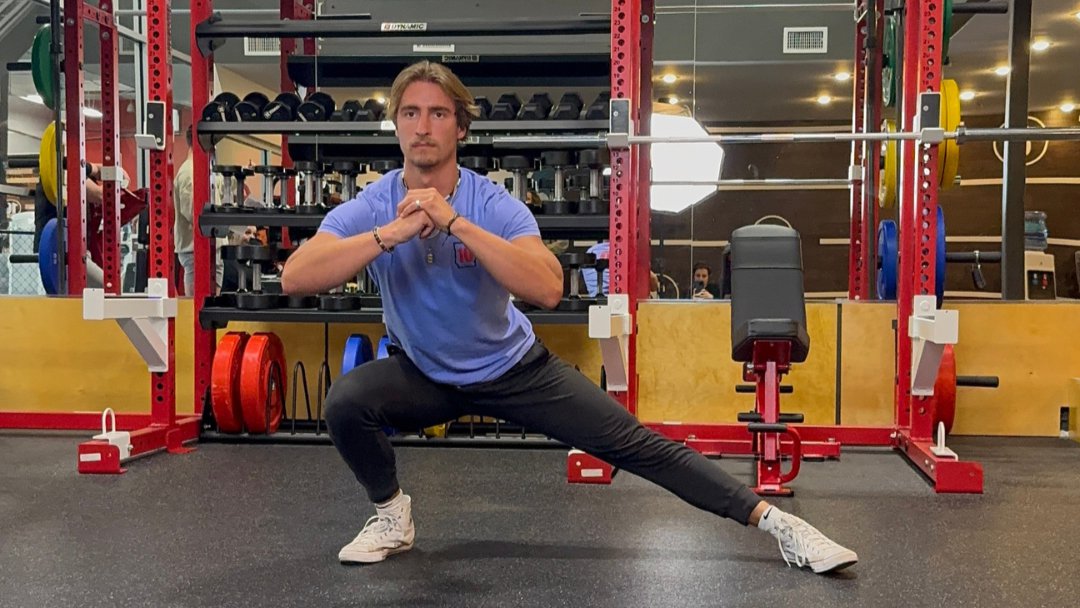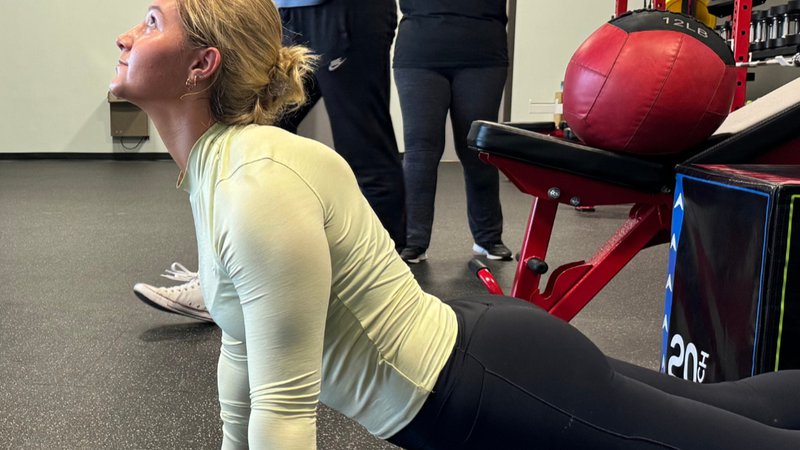
When aiming to stay fit without wasting time, every move matters. Stretching demands effort, so it should provide tangible results. The reality is that effective post-workout stretches can ease soreness, support recovery, and protect progress. This guide explains the real post-workout stretching benefits and how to do it right.
Key Takeaways:
- Stretching improves flexibility and joint mobility, especially when muscles are warm.
- Static stretching (hold 20–60 sec) is best post-workout; it relaxes muscles, slows the heart rate, and increases range of motion.
- Dynamic stretching is not ideal after exercise; it’s better for warming up.
- Stretching does not prevent or reduce soreness (DOMS) or speed muscle recovery, according to research.
- It boosts circulation, helping deliver nutrients and remove waste like lactic acid.
- It activates the parasympathetic nervous system, lowering cortisol and promoting calm.
- Stretching supports injury resistance by keeping muscles and joints in balance.
- Ideal routine: 5–10 minutes post-workout, hold each stretch 30–60 seconds, breathe deeply.
- Avoid mistakes: overstretching, bouncing, bad form, and holding your breath.
Key Benefits of Stretching After a Workout
Stretching after a workout offers more than just relaxation. Post-exercise stretching helps your muscles recover optimally, boosting flexibility and reducing stiffness. Here are some compelling benefits of incorporating stretching into your routine.
Does Post-Workout Stretching Aid in Muscle Recovery and Reduce Soreness?
Yes, stretching supports recovery by enhancing blood flow to tired muscles, easing tension, and facilitating smoother movements the next day. Reported benefits include:
- Reduced stiffness after workouts.
- Lower risk of joint and muscle strain due to maintained tissue softness.
- Soothing tense muscles and improving circulation through static stretching.
For long-term progress, stretching post-workout offers a simple, cost-effective way to continue improvements. Learn more about fitness benefits at 10 Fitness.
How Does Stretching Improve Blood Flow and Nutrient Delivery?
After workouts, the body’s blood vessels are expanded, making it an ideal time for stretching, which enhances:
- Blood flow to muscles, delivering vital oxygen and nutrients to aid healing.
- Removal of waste products like lactic acid, contributing to effective recovery.
Just five minutes of static stretching can significantly enhance blood flow and restore balance.
Can Stretching Lower Stress and Support the Nervous System?
Stretching effectively shifts the body from a high-alert mode to a relaxed state by:
- Reducing cortisol levels, the primary stress hormone.
- Lowering heart rate and relaxing muscles, leading to an improved mood.
Clients often experience a clearer, more relaxed state of mind post-stretching.
Stretching Benefits After Workout: How It Supports Overall Well-being
Post-workout stretching benefits extend beyond physical recovery, aiding mental relaxation and preparing the body for the next exercise session:
- Promotes both physical and mental restoration.
- Sets the foundation for future workouts by maintaining flexibility and joint health.
For more insights into staying fit and achieving your wellness goals, explore 10 Fitness.
How Does Stretching Support Muscle Recovery and Delay Soreness?
Stretching Benefits After Workout: Myths and Realities
Does stretching improve recovery after a workout? No, not in the way most expect. Research indicates that stretching doesn’t accelerate muscle repair. A 2021 review of multiple studies found no significant impact on recovery or reduced soreness. Individuals who stretch don’t necessarily heal faster than those who simply rest.
Why Stretch Post-Workout?
Even though stretching doesn't expedite recovery or alleviate deep muscle ache, it offers other valuable benefits. Stretching post-workout enhances body awareness, soothes tight areas, and improves joint function—key components of long-term fitness. For more on how stretching supports your fitness journey, see 10 Fitness Benefits.
Can Stretching Alleviate Soreness?
No. Research, including a study from the National Center for Biotechnology Information, reveals no significant reduction in muscle soreness (DOMS) 24 to 72 hours post-exercise. Soreness typically results from micro-tears in muscle tissue caused by intense workouts, which stretching cannot prevent. Explore more about effective fitness strategies on 10 Fitness.
The True Benefits of Post-Workout Stretching
Though it doesn't directly reduce soreness, stretching is useful in promoting blood flow, relaxing the nervous system, and fostering self-care, contributing to overall well-being. Additionally, stretching enhances circulation, facilitating the delivery of nutrients to muscles and the removal of metabolic waste, thereby aiding recovery in subtle ways.
Tackling Misconceptions: Lactic Acid and Tightness
The idea that stretching clears lactic acid is inaccurate. Lactic acid dissipates from muscles within about an hour post-exercise. What's often left is not due to lactic acid buildup. Moreover, mild post-exercise tightness is normal and contributes to muscle adaptation and strengthening rather than being an issue requiring correction.
Should Stretching Be Skipped After Workouts?
No, but it's important to rethink expectations. Stretching should not be viewed as a quick fix for recovery. Instead, focus on its role in maintaining posture, alignment, and relaxation. For a deeper understanding, refer to this comprehensive review on stretching and recovery.
Investing time in a well-rounded fitness routine? Stretching continues to hold value—as part of an ongoing commitment to fitness progress.

The Difference Between Static and Dynamic Stretching: Understanding Post-Workout Benefits
Static and dynamic stretching play unique roles in fitness routines, particularly after workouts. Understanding their benefits and when to use each can enhance recovery and flexibility.
Stretching Benefits After Workout
What Is Static Stretching for?
Static stretching is essential for post-workout routines. Holding a stretch for 20 to 60 seconds relaxes muscles, enhances flexibility, and calms the body. This approach is ideal after exercise, as warmed muscles respond more effectively to stretching. Recommended poses include the hip flexor lunge, hamstring reach, and quad pull. These exercises are beneficial after activities like lifting, cardio, or sports sessions.
Explore more benefits of stretching at 10 Fitness.
Is Dynamic Stretching Helpful After Workouts?
Dynamic stretching is not recommended post-exercise. These movements, which involve swinging, bouncing, or quick twisting, are most effective before workouts. They elevate the heart rate and prepare the joints but do not contribute significantly to recovery afterward. Post-exercise, the body requires cooling down, so dynamic moves like high knees or arm circles offer little assistance in recovery.
Which Type Supports Better Recovery and Flexibility?
Static stretching is more advantageous for recovery and flexibility post-workout. While dynamic stretching shows minimal benefits after training, static holds effectively relax tight areas and reduce the risk of post-exercise discomfort.
For additional insights, refer to the Hospital for Special Surgery's comparison on dynamic vs static stretching.
Choosing the Right Stretching Routine
For effective post-exercise recovery, prioritize static stretching. Engage in steady, quiet stretches targeting areas like the hips, calves, quads, and spine. This approach supports better recovery and aids in maintaining flexibility.
To continue enhancing your fitness journey, discover stretching routines and more at 10 Fitness.
How Stretching Benefits After Workout Improve Flexibility and Mobility
Enhancing Ease of Movement
Stretching post-workout helps maintain ease of movement, essential for daily activities like squatting and walking. It prevents stiffness and promotes seamless motion.
Increasing Flexibility
Short answer: Stretching restores length to muscles tightened during exercise. This relaxation allows muscles to regain their full range, enhancing flexibility and movement.
The Effect on Muscles
Intense training often tightens muscle fibers. If not stretched, the tension remains. Stretching encourages these fibers to relax, facilitating better motion and preventing issues like tight hips, which can strain the back.
Improving Range of Motion
Consistent stretching over time improves joint range of motion, resulting in stronger and more comfortable movements. Regular static stretching, particularly post-exercise when muscles are warm, aids this process. Recommended stretches include the seated hamstring stretch or quad hold.
For more insights, explore 10 Fitness's benefits of fitness.
Timeframe for Flexibility Improvement
Significant changes occur over weeks to months, although reduced tightness can be felt in just days. Consistency is key to progress.
Maintaining a Stretching Routine
Begin with five-minute sessions at the end of each workout, focusing on critical areas like hips, legs, and back—no equipment needed, just commitment.
Learn more about stretching at 10 Fitness.
How Stretching Benefits After Workout Help Prevent Injuries
Reducing Injury Risk
Yes—if done correctly. Stretching post-workout supports joint health and muscle relaxation. Tight muscles, if left unchecked, can tug on bones and limit movement. Stretching keeps everything balanced.
Proper Stretching Technique
- Hold each stretch for 30 seconds
- Breathe steadily
- Avoid forcing the stretch
Focus on major muscle groups used during training, such as hips, legs, and back. Utilize slow, controlled motions without bouncing.
Misconceptions About Soreness
While stretching may not eliminate soreness immediately, it alleviates tension, particularly in hips and back, if cooldowns are not skipped.
Explore effective fitness strategies for further guidance.
How Stretching Supports Joints and Tendons
Flexibility enables tissues to move fluidly, enhancing the cooperation between muscles and joints. Lack of flexibility increases the risk of injuries like knee twists or back tweaks.
Research on Injury Reduction
Though results are mixed, regular stretching contributes to better balance, motion, and joint health—factors supporting injury resistance.
Over time, individuals who incorporate stretching, especially older adults and athletes, experience improved mobility and reduced pain. Consistency is vital, much like brushing teeth—skipping leads to issues.
For tailored stretching plans, consult a trainer. Meanwhile, dedicate a few minutes post-workout to maintain your body's well-being.
Find more fitness tips at 10 Fitness.
Effective Post-Workout Stretching Benefits
Stretching after a workout is essential for easing muscle tension and improving flexibility. Here's an optimized routine for a complete cooldown.
Best Stretch Techniques for Recovery
SQuAD Answer Style: The best routine uses static stretches for all large muscle groups to optimize post-workout recovery.
Full-Body Stretching Benefits After Workout
- Neck and Shoulders: Gently tilt your neck side to side to release tension. Reach up and bend left and right for shoulder relaxation.
- Back and Hamstrings: Fold forward to ease your lower back and hamstrings. End in a child’s pose to soothe the spine.
Explore more on 10 Fitness's guide to fitness.
Stretching Benefits After Workout by Muscle Group
- Hamstrings: Sit with straight legs and reach forward.
- Quads: Stand and pull your ankle towards your glutes for a quad stretch.
- Calves: Stand facing a wall, step back, and press the heel down.
- Back: Utilize cat-cow poses for slow, controlled movement.
- Hips: Kneel and tilt hips forward for a deep stretch.
New to Exercise or Training Hard?
Begin with 3–5 stretches, holding each for 30 seconds while ensuring comfort. Aim for comprehensive cooldown routines with stretches lasting up to 60 seconds using deep breathing techniques. Learn more about exercise benefits.
Addressing Back Pain with Stretching Benefits After Workout
Tight hips and hamstrings can impact the spine. Incorporate child’s pose, knee-to-chest, and lying-down piriformis stretches to alleviate lower back discomfort.
How Stretching Benefits After Workout Aid in Circulation and Recovery
Stretching swiftly post-workout enhances blood flow to muscles, delivering oxygen and removing waste. Exercise induces a buildup of waste like lactic acid, and stretching aids in its removal through improved circulation.
One study highlighted stretching's role in enhancing oxygen delivery to strained muscles, facilitating repair. Stretching also reduces fluid retention, calming both the body and mind.
Explore how fitness routines support health.
Mental and Emotional Wellness Through Stretching Benefits After Workout
How Stretching Promotes Relaxation
Stretching initiates the parasympathetic nervous system, responsible for calming the body by lowering heart rates and easing breath. This results in feeling more grounded.
Incorporate deep breathing: inhale through the nose, hold briefly, and exhale slowly to support cortisol reduction, your main stress hormone.
Enhancing Mood Through Stretching
Stretching post-exercise engages mindfulness, focusing on the present, and relaxing physically and mentally. Practicing stretching before sleep can also improve rest by releasing tension.
Timing and Duration: Maximizing Stretching Benefits After Workout
Stretch for 5 to 10 minutes post-training to loosen tight areas and slow the heart rate. Hold each stretch for at least 30 seconds and extend to 60 seconds for tighter muscles.
- Post-Run/Bike: Focus on calves and quads.
- After Weights: Stretch arms, back, and hamstrings.
This practice supports long-term motion and injury resistance. Regular stretching post-exercise resets both body and mind. Discover more on effective training with 10 Fitness.
Avoid Mistakes in Stretching Benefits After Workout
Common Mistakes and Solutions:
- Pain: Stretching should never cause pain. Feel a gentle pull only.
- Overstretching: Avoid pushing too hard to prevent joint and muscle strain.
- Bouncing: Maintain steady holds to prevent tears and soreness.
- Poor Form: Align your spine and engage your core to maximize effectiveness.
- Breath Holding: Keep breathing steadily to aid relaxation.
Proper post-workout stretching boosts recovery, flexibility, and calmness. Avoid poor habits, stretch smart, and learn more about fitness with 10 Fitness.
Join 10 Fitness and Achieve Your Goals
Looking to build strength and save money? At 10 Fitness, we make staying fit both simple and affordable. Our state-of-the-art facilities and expert trainers will support you on your fitness journey, offering customized plans and motivation to help you reach your goals without breaking the bank. Discover how our services improve flexibility, enhance recovery, and boost overall well-being. Ready to take the next step? Contact us now to learn more about our membership plans or visit us at 10 Fitness. Have questions? Feel free to get in touch with us here.

